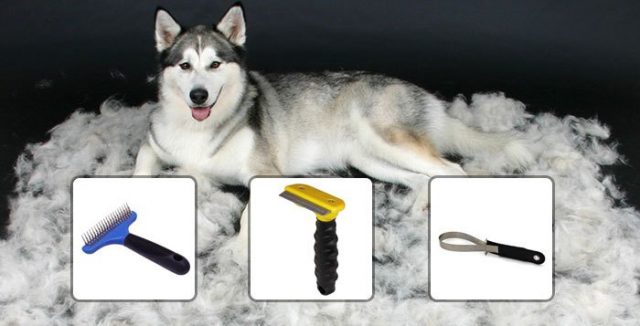
Groom me, please! Siberian Huskies shed their undercoats twice a year. This is called “blowing the coat,” and it usually occurs in spring as the weather warms, and again in fall to make way for growth of a new undercoat for the cold weather ahead. You should never have the undercoat of your Siberian Husky manually removed. Regular grooming, not undercoat removal, is the secret to keeping your Siberian Husky clean and comfortable. In addition, it is important to never shave a Siberian Husky, as the coat provides natural insulation both against summer heat and winter cold, and it protects the Husky’s skin from sunburn. Remember it doesn’t matter if you have a fluffy husky, long haired husky or a short haired husky, all huskies require grooming.
Husky puppies have a soft fuzzy undercoat but no real guard hairs to speak of. But between the ages of 10 and 14 months, Husky puppies will go through a complete shed losing all their of their fuzzy puppy fur. The puppy fuzz is then replaced by their full adult coat.
Never Clip Or Shave Your Husky
At least once a year the Siberian Husky sheds his entire undercoat. This process can last up to six weeks from start to finish. All dead hair needs to be brushed out to enable quick and strong re-growth. A warm bath and a blow dry will encourage the hair to drop out evenly and easily – making it easier to comb out.
In their natural climate of Siberia the Husky does not shed during the year (except when they blow their coats) due to the cold and dry environment. But if you don’t live in Siberia you will find that the husky tends to shed throughout the year. Shedding is a natural process. Dogs perspire only through their paw pads so getting rid of extra hair in the summer is an absolute necessity to prevent heat stress.
Overall the Siberian Husky needs very little grooming compared to other breeds, no trimming of hair is needed, just a regular brush to remove any dead hair. Do not shave, strip or clip your husky close. The undercoat insulates against the coat and the top provides protection from harmful ultra violet sun rays and should not be cut short.
Never clip your huskies whiskers – they are sensory devices that your dog needs. Whiskers vibrate as a warning to the dog when they come into contact with something solid.
Tips for Brushing Your Dog
The key to happy grooming is to teach your Siberian to accept being brushed and standing or laying quietly while it is being done. Wild dogs perform grooming sessions on each other frequently, it promotes social cohesion and reaffirms the hierarchy.
Regular short grooming sessions should be undertaken at least once a week to keep his coat healthy and shiny. Some people tend to forget about grooming as the winter turns cold and this is a big mistake. In the wet months the coat can begin to mat if it is not regularly brushed, matting destroys the insulating properties of the undercoat and makes for a very cold husky.
When brushing start with a wide toothed comb, preferably one with rounded teeth – this will help break up any mats. Then proceed to brush the coat vigorously, following the way the hair grows. Do small sections of the coat at a time.
Be sure to groom the whole husky, including the belly and underneath the tail where mats often hide!
Your grooming routine should include a flea inspection. Use a fine toothed metal flea comb, keep a glass of hot water nearby to dip the flea bearing comb in – the fleas will drown.
The Tools We Recommend For The Job:
- Undercoat Rake
- Furminator
Cleaning and Bathing Your Dog
Siberian Huskies commonly groom themselves much as cats do. Their furry undercoats contain natural oils that help to repel dirt. This means Siberians generally need bathing just once or twice a year. More frequent bathing can dry out the natural oils, causing skin problems. Used regularly, the conditioner and water solution helps to clean the dog and leaves a fresh scent and a shine on the coat, as well as helping to loosen tangles. When it is necessary to bathe the dog, use a shampoo formulated for dogs. Rinse several times after bathing to remove any shampoo residue. Clean the inner surface of the dog’s ears, using a cotton ball soaked in mineral oil to help guard against ear mites.
The Tools We Recommend For The Job:
- Shampoo
- Grooming glove
References & Resources
- Grooming, by myhusky.com.au, retrieved from the web on January 23, 2018.
- How often should you have your Siberian Huskies undercoat removed, by team petcarerx, retrieved from the web on January 23, 2018.
- How To Groom Your Husky, by Snow Dog Guru, retrieved from the web on January 23, 2018.

